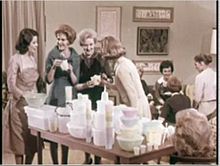Company history
Tupperware was developed in 1948 by Earl Silas Tupper (1907–83) in Leominster, Massachusetts.[3] He developed plastic containers used in households to contain food and keep it airtight. The formerly patented "burping seal" is a famous aspect of Tupperware, which distinguished it from competitors.
Tupperware pioneered the direct marketing strategy made famous by the Tupperware party. Brownie Wise(1913–92), a former sales representative of Stanley Home Products, developed the strategy. During the early 1950s, Tupperware's sales and popularity exploded, thanks in large part to Wise's influence among women who sold Tupperware, and some of the famous "jubilees" celebrating the success of Tupperware ladies at lavish and outlandishly themed parties. Tupperware was known—at a time when women came back from working during World War II only to be told to "go back to the kitchen"[4] —as a method of empowering women, and giving them a toehold in the post-war business world.[5][6][7]
The tradition of Tupperware's "Jubilee" style events continues to this day, with rallies being held in major cities to recognize and reward top-selling and top-recruiting individuals, teams, and organizations.
In 1958, Earl Tupper fired Brownie Wise over general difference of opinion in the Tupperware business operation. Officially, Tupper objected to the expenses incurred by the jubilee and other similar celebrations of Tupperware,[8] however, the real reason was that Tupper had been approached by several companies interested in buying him out; he felt that he would not be able to sell with a woman in an executive position.[9]Rexall bought Tupperware in 1958. Tupperware spread to Europe in 1960 when Mila Pond hosted a Tupperware party in Weybridge, England, and subsequently around the world. At the time, a strict dress codewas required for Tupperware ladies, with skirts and stockings (tights) worn at all times, and white gloves often accompanying the outfit.[10] A technique called "carrot calling" helped promote the parties: representatives would travel door to door in a neighborhood and ask housewives to "run an experiment" in which carrots would be placed in a Tupperware container and compared with "anything that you would ordinarily leave it in"; it would often result in the scheduling of a Tupperware party.[10]
Rexall sold its namesake drugstores in 1977, and renamed itself Dart Industries. Dart merged with Kraftco to form Dart & Kraft. The company demerged, with the former Dart assets named Premark International.Tupperware Brands was spun off from Premark in 1996; Premark was acquired by Illinois Tool Works three years later.[citation needed]
In 2003, Tupperware closed down operations in the UK and Ireland, citing customer dissatisfaction with their direct sales model.[11] There has been limited importer-distribution since then.[12] The company announced a formal relaunch in the UK in mid-2011,[13] and recruited UK staff, but in December the relaunch was cancelled.[14]
Tupperware is now sold in almost 100 countries, after peaking at more than a hundred after 1996.[15]


No comments:
Post a Comment